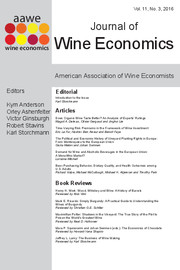Growers vs. Merchants Bargaining on the Price of Champagne Grapes and The Role of Contracts when Bargaining is Unbalanced
Journal of Wine Economics , Volume 1, Number 2, Pages 95–113
Publication year: 2006
The contract between growers and merchants for the exchange of grapes on the Champagne mar-
ket is a long-term agreement based on quantities. Commitments on quantities are made for several
years and negotiated individually between growers and merchants. Each year, prices are negotiated
at the interprofessional level, the interprofessional committee including members of the growers
union, members of the merchants union and a government commissioner. It turns out that indus-
trial organization theory, and more precise mechanisms outlined by incomplete contract theory are
relevant to the analysis of such contracts in which prices and quantities are negotiated sequentially
and by different groups of actors. We show that imposed pricing by the interprofessional organiza-
tion can, in some cases, balance the bargaining power between growers and merchants and thus
increase social welfare. At a time when the European Common Organization of Wine Markets
casts doubt on interprofessional organizations, this result tends to justify their positive role.



